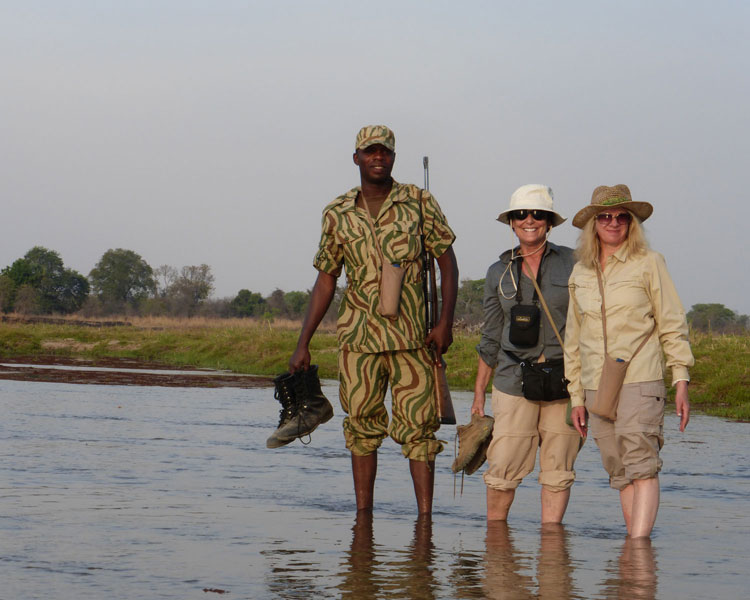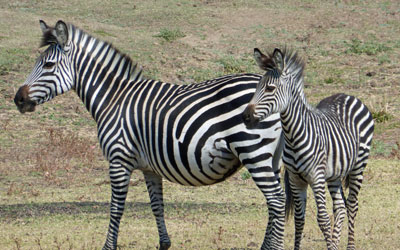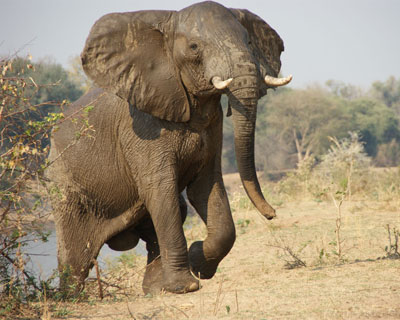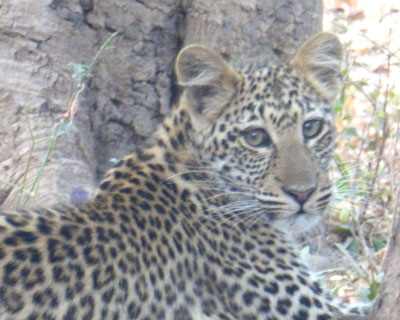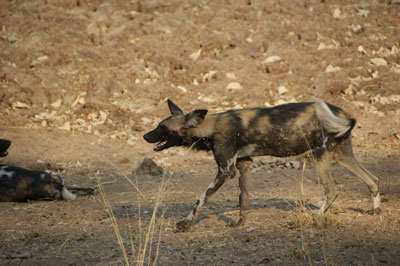A walking safari for two in Zambia
This article appears on page 6 of the April 2015 issue.
“We saw wild dogs, lions, leopards, elephants, Thornicroft’s giraffes and honey badgers, all with their young and all on the first three days of our 11-day safari in South and North Luangwa National Park. And I planned it all with just a few emails to Jessica “Jess” Salmon at Flatdogs Camp. No tour company or travel agent was involved.”
That is the way I brag about the trip to Zambia that my coworker Mary Anne Scott and I took in September-October 2014.
The plan
I relish trip planning. My planning strategy is to arrange a journey that is unique, that inspires a personal experience that may not be available from a tour company’s set itinerary. Of course, I do consult preset itineraries, but then I customize by adding the experiences and locations that I desire.
Zambia is an unusual choice for many North Americans, but it delivers a special safari experience.
After I checked out recommendations in our Lonely Planet guidebook, Flatdogs Camp (phone +260 [0] 216 246038, www.flatdogscamp.com) seemed like the perfect place to begin our adventure. I emailed Jess Salmon to discuss the possibility of a safari that included walking in North Luangwa National Park.
Walking safaris were developed in South Luangwa National Park in the 1950s. Walking safaris there are not about walking nature trails and identifying scat (poop). Instead, every walking safari there — in fact, everything in South and North Luangwa National Park — is about seeing, tracking and observing animal behavior.
Even though Flatdogs is one of the biggest and best camps in South Luangwa National Park, the booking that Jess organized with Remote Africa Safaris was so seamless, it was hard to imagine that the two companies were not affiliated.
My safari plans took shape after I booked the airfare. Ethiopian Airlines (800/445-2733, www.ethiopian
airlines.com) provided excellent connections — from Columbus, Ohio, to Lusaka, Zambia, with stops in Toronto, Canada, and Addis Ababa, Ethiopia. The cost was $1,385 per person, round trip.
We had prearranged assistance in obtaining a $50 visa upon arrival.
Our Sunday afternoon arrival did not permit us to fly to Mfuwe (on the “right wing,” if you see Zambia as shaped like a butterfly), where our safari would begin at Flatdogs Camp, so we stayed overnight in Lusaka. A Sunday craft market was located behind our hotel, Protea Hotel Lusaka Tower. At the craft market, we found a talented stone sculptor and above-average crafts.
Flatdogs Camp
The remarkable aspect of this safari is that it seemed so easy to personalize the experience; just ask and it magically appeared. That was certainly true of our time at Flatdogs Camp, where I met Jess Salmon and her partner, Ade Coley, the camp managers. Our entire tour package cost $6,315, which included all accommodations (four camps and two hotels), internal flights and all activities and meals.
Flatdogs was the only permanent camp at which we stayed. The accommodations there were in tents overlooking a riverbed.
After lunch on our second day, we watched more than 100 elephants cross the river as we sat on the front porch of our tent. When five of them stood 10 feet from us, we quickly moved inside the tent and zipped it up. It was thrilling!
Unlike on any other safari I have experienced, Flatdogs had an extensive à la carte menu rather than a buffet. Order what you want; it’s all included.
The food was great throughout our trip. The “wow” factor was in having so many choices, including six daily specials that were available anytime.
After breakfast, Walleia took us on a game drive with one other guest. All game drives were in open-air, tiered vehicles, so a “window” seat was guaranteed.
The morning drive at Flatdogs would typically be from 7 until 10, with the evening drive starting around 4:30 and ending at 8. It was easy to substitute a morning walking safari if we wanted.
The midday break allowed for a leisurely lunch (indoors or out), a quick dip in the pool and a visit to the local school or the batik artists’ workshop (tribaltextiles.co.zm), all available for the asking.
The whispered requests for animal sightings were as easily fulfilled. Twin leopard cubs sat under a tree and posed for the three of us.
The three days at Flatdogs yielded the best photographs. It is where my bragging always begins.
Crocodile Camp
On the morning of our third day, Walleia took us on an extended game drive to search for the wild dogs we had seen the day before, then he waved good-bye as we set out on a small flat-bottomed boat for a brief river crossing to meet Alex, our first guide from Remote Africa Safaris.
Our next three camps would be 6-person walking camps. The accommodations were thatched chalets, with flushing toilets and showers open to the stars.
Crocodile Camp was perfectly situated, looking out on a dry riverbed with a popular watering hole. We saw a leopard come in to drink both nights as we were enjoying our sundowners.
On our first walking safari at Crocodile Camp, we saw two lions, one of which climbed a hill and came within 20 feet of our group. It was empowering to think that a healthy female lion would be intimidated by our group, but she quickly retreated and joined her companion in the brush.
Our walking group of six had the same effect on a group of buffalo that numbered more than 300, which turned and ran as we approached.
As I write this, all of our walking camps — Crocodile, Chikoko and Mwaleshi — are being torn down for the rainy season, November through April. In May they will reopen with fresh thatch, a newly built kitchen and flushing toilets. It’s magic!
This is the place to celebrate the sun and the stars. The morning walk started at around 6:00 and lasted about four hours. The “paths” were animal trails. The ground was flat and the pace, slow.
All walks were accompanied by a guide, an armed scout and, typically, a tea bearer, who set out hot drinks and cake during our break.
The afternoon walk started after tea, and freshly baked cake was enjoyed at about 3:30. This walk always ended before dark, but the opportunities for seeing the sunset were abundant.
Sometimes we took in the last glimpses of the day around the campfire sipping gin-and-tonics and watching the parade of animals getting into their nighttime regimes.
Another difference between the walking camps and Flatdogs is that all alcohol and all laundry service were included.
After two nights at Crocodile, we walked to our next camp, Chikoko, for a 24-hour stay. Chikoko Camp featured a 2-story chalet with a second-story porch that looked out over a lush plain. Veteran guide Isaac Zulu, who trained under British conservationist Norman Carr, was our guide/camp manager.
Heading north
The new day started with a quick river crossing and a memorable ride to the airport. A charter flight was organized to North Luangwa National Park, included in our trip price.
On the drive, we watched a sleeping leopard raise its head, turn and stretch out on a tree limb. A crocodile opened its mouth for another good photo as we stopped to observe a group of baby hippos.
At the airstrip, we hopped into the 4-passenger Cessna (along with a dozen fresh eggs) for our 25-minute flight to North Luangwa National Park.
Only 500 or so people visit North Luangwa Park each year, and there are only two camps there that I am aware of. We stayed at Mwaleshi, the more upscale of the two.
“Remote” is usually more expensive, and the cost of a night’s stay at Mwaleshi was $594 per person, compared to Flatdogs’ rate of $375.
At camp we were met by Ernst Jacobs, one of their legendary guides. He is South African by birth and was our only non-Zambian guide. No worries — his native language is English, just like that of the locals.
The landscapes were more diverse in North Luangwa. One day we walked across a desert landscape where the signposts were actually sun-bleached animal bones.
We were fortunate to meet Ed and Claire Sayer, who run the rhino project previously operated by Delia and Mark Owens, who are memorialized in the book “The Eye of the Elephant.”
We readily accepted their invitation to visit their home and the rhino project the next day. At Mwaleshi Camp, a vehicle is provided for just this type of opportunity.
We enjoyed watching the Sayers’ toddlers play with their new pet, a 3-week-old bushbuck, while we had a coffee break. Despite a full day in the rhino preserve, we did not see any of the protected rhinos, but we sighted large groups of healthy animals.
Mary Anne purchased a lovely watercolor that Ernst painted at our lunch stop. She will be able to look at the painting and remember watching the elephant families come in to drink at the river.
On our last full day at Mwaleshi, we were the only two guests. At 5:30 a.m., we sat around the campfire, toasting our homemade bread on the open flame, then smearing it with freshly ground peanut butter. After coffee and toast, we were ready to take off our shoes and cross the river to begin our morning walk.
The game-viewing opportunities were enhanced by driving to the area of interest, then starting our walk. We used this tactic with great success during our stay in North Luangwa National Park.
The evening started and ended with a game drive. Between the drives, we walked to the sandbars to watch the sun set as the hippos spent the last hours of their day in the river. (I bought Ernst’s watercolor of the pink bathing hippos.)
The next morning, we saw a porcupine with all its quills extended run in front of us on our walk. A perfect finale to our remote safari!
But our search for the memorable experiences did not end with our flight back to Lusaka. Oh, no; Mary Anne and I were now in search of great souvenirs, especially jewelry.
City shopping
Our international flight was scheduled for a late-afternoon departure the next day. In order to make the best use of our time on this last day in Zambia, I asked Jess to book an overnight at the StayEasy Hotel in the Fairview area, located on the other side of Lusaka, because it was closer to the best shopping. More importantly, she arranged for Friday Mwale (friday
mwale@yahoo.com) to be our driver.
When Friday picked us up at the Lusaka airport, we asked him to take us to the best jewelry store in the country. My research indicated that was Jagoda (1 Luano Rd.; www.jagodagems.com).
Exquisitely styled jewelry crafted with exotic Zambian gems can be found there for very reasonable prices. (Because sterling silver and gold-plated sterling are used to set the fine gems, rather than purely gold, the prices are relatively lower.)
Realizing that this was our best chance to buy something wonderful, we handed over our Visa and MasterCard to the delightful female employees, leaving after the official closing time with rings and earrings, feeling giddy that we had gotten to see so many great pieces.
On our last morning, we asked Friday to take us to Kabwata Cultural Village on Burma Road. This collection of huts serves as shops for local craftspeople. After inspecting the six or so shops, we returned to the women’s cooperative to make most of our purchases.
My purchases of small stuffed animals made in bright local fabrics and small carved wooden bowls decorated with traditional prints became gifts that were warmly received.
We then returned to Jagoda and did a lot more damage to our credit cards. As Friday drove us to the airport, we admired our rings made of spessartine garnet and multicolored sapphires in the bright sunlight, and we talked about walking with the lions.

